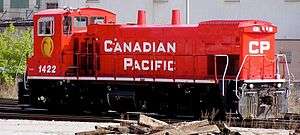EMD MP15AC
The EMD MP15AC is a 1,120 kW (1,502 hp) diesel switcher/road-switcher locomotive built by General Motors' Electro-Motive Division between August 1975 and August 1984. A variant of the EMD MP15DC with an AC transmission, 246 examples were built, including 25 for export to Mexico, and four built in Canada.
| EMD MP15AC | |||||||||||||||
|---|---|---|---|---|---|---|---|---|---|---|---|---|---|---|---|
 | |||||||||||||||
| |||||||||||||||
| |||||||||||||||
| |||||||||||||||
| |||||||||||||||
Development
The MP15DC’s standard Blomberg B trucks were capable of transition and road speeds up to 60 mph (97 km/h), allowing use on road freights. Soon there was a demand for a model with an advanced AC drive system. The MP15AC replaced the MP15DC’s DC generator with an alternator producing AC power which is converted to DC for the traction motors with a silicon rectifier. The MP15AC is 1.5 ft (457 mm) longer than an MP15DC, the extra space being needed for the rectifier equipment. The alternator-rectifier combination is more reliable than a generator, and this equipment became the standard for new diesel-electric locomotive designs.
The MP15AC is easily distinguished from the DC models. Instead of the front-mounted radiator intake and belt-driven fan used on all previous EMD switchers, these have intakes on the lower forward nose sides and electric fans. Side intakes allowed the unit to take in cooler air, and the electric fans improved a serious reliability issue found in its earlier DC sisters.[1][2]
Engine
The MP15 used a roots-blown 12-cylinder 645E engine.[3] The engine is rated at 1,500 hp (1,120 kW).[4] The 645 series, introduced in 1966, was EMD’s standard engine through the 1980s.[1] [5]
The six largest buyers, Milwaukee (64), Southern Pacific (58), Seaboard Coast Line Railroad (45), Nacionales de México (25), Long Island (23), and Louisville & Nashville (10), were all buying AC road locomotives. 36 more units were sold to 8 other customers.
See also
References
- Pinkepank, Jerry A.; Marre, Louis A. (1979). Diesel Spotters Guide Update. Kalmbach Books. pp. 4–9. ISBN 0-89024-029-9.
- Johnston, Howard; Harris, Ken (2005). Jane's Train Recognition Guide. HarperCollins Publishing. pp. 414, 425. ISBN 978-0-06-081895-1.
- "Proceedings of the American Railway Engineering Association". American Railway Engineering Association: 106. 1974.
Specifications are standard throughout for GM locomotives fitted with the Series 645 engine; MP15 has a 12- cylinder 645E roots-blown version.
- Solomon, Brian, 1966- (15 June 2016). The field guide to trains : locomotives and rolling stock. Minneapolis, Minnesota. p. 44. ISBN 978-0-7603-4997-7. OCLC 928614280.CS1 maint: multiple names: authors list (link)
- Pinkpank, Jerry A (1973). The Second Diesel Spotter's Guide. Kalmbach Books. p. 26. LCCN 66-22894.
- Marre, Louis A. & Pinkepank, Jerry A. (1989). The Contemporary Diesel Spotter's Guide. Waukesha, WI: Kalmbach Books. ISBN 0-89024-088-4. LCCN 88083625. OCLC 19959644.
| Wikimedia Commons has media related to EMD MP15AC locomotives. |
External links
- Sarberenyi, Robert. EMD MP15DC, MP15AC, and MP15T Original Owners